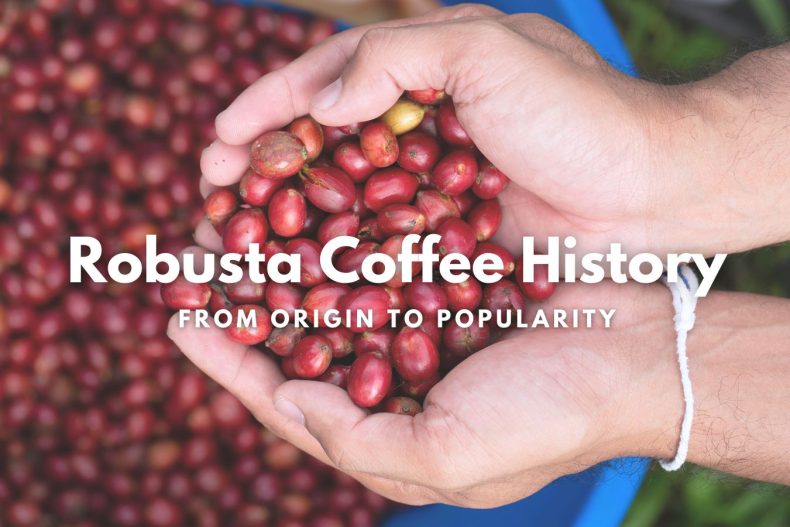
Coffee is a daily ritual for millions of people worldwide, and its history is as rich and complex as the flavors it offers. Ethiopia, the birthplace of Coffee, has a long and fascinating story behind its iconic beverage. This article will explore Ethiopian Coffee History, from its ancient roots to its modern-day culture and impact on the global coffee industry.
Introduction: Ethiopian Coffee’s Significance
Ethiopia is widely regarded as the birthplace of Coffee, and its long and rich history is intertwined with the beverage. Coffee is more than just a drink in Ethiopia; it’s a cultural icon that has shaped the country’s identity for centuries. Ethiopia remains one of the world’s top coffee producers, known for its unique and high-quality beans. Understanding the history and culture behind Ethiopian Coffee is crucial to appreciate the beverage fully.
Early Ethiopian Coffee History: Legend of Kaldi and origins of Coffee
According to legend, Coffee’s origins can be traced back to ancient Ethiopia, where a goat herder named Kaldi discovered the stimulating effects of Coffee after noticing his goats became energetic after eating the beans. From there, Coffee became a part of religious ceremonies and was consumed by Ethiopian monks to stay alert during long prayers.
Coffee is frequently credited with having originated in Ethiopia. According to many experts, Ethiopia is the only country where coffee was domesticated, and the fictitious tale of Kaldi is frequently told. After observing the strength that his goats gained from consuming the cherries, Kaldi, a goat herder, found coffee. Later, he took these cherries to the monastery and gave them to the monks, who swore they were the devil’s product and threw them into the fire. The roasted beans’ divine perfume filled the air as they were scraped from the fire and smashed to extinguish the embers.
When they realized their error, they put them in a jug and covered them with hot water to preserve them. The beverage was afterward consumed by the monks, who said it kept them awake during midnight devotions. While this tale is entertaining, it is more than likely that the Oromo, a nomadic people, were the first to learn about the coffee plant and its stimulating properties. There are numerous fictitious origin legends about coffee, and little is known about how it was discovered.
Spread of Coffee: Monasteries and the Silk Road
The spread of Coffee worldwide can be traced back to Ethiopia’s monasteries, where the beans were first cultivated and traded. Coffee soon became popular along the Silk Road trade route, eventually spreading to Europe, Asia, and the Americas. Ethiopia remains a crucial player in the global coffee industry, producing some of the world’s best beans.
The rest of Ethiopia’s coffee history is somewhat chaotic. Ethiopia’s government has undergone a lot of changes. They have only had three different types of government in the past 40 years, starting with a military Marxist philosophy and ending with the current federal system.
These regimes have responded to significant public discontent, insurrection, and political instability. Ethiopia was engaged in conflict with Eritrea from 1998 until 2000. There have been a lot of deaths and terrible suffering due to this fight with Eritrea (and other conflicts). Additionally, it restricted access to land and sparked a recession. The war was said to have cost billions of dollars.
Ethiopian coffee farming suffered greatly due to the unsettling political and economic environment. The price of coffee fell to its lowest point ever in 2003. Many farmers abandoned their crops because the price of coffee no longer covered the cost of production. They were heartbroken because they lacked the funds to pay for home maintenance, buy clothes, or provide their kids a good education. While some farmers continued to work on their coffee plantations, others moved from their farms to the cities.
Despite these difficulties and problems, coffee is still Ethiopia’s top export. Ethiopian coffee farmers may have to compete and team up with more significant, more powerful firms that frequently take the lion’s share of the profit. Farmers receive little money from these alliances, and Ethiopia’s coffee-producing women receive much less, often as low as $20 per month.
The National Coffee Board of Ethiopia was established in 1957 to enhance the quality of Ethiopian coffee and bring together farmers, merchants, and exporters. Fair Trade organizations have also recently aided in ensuring that coffee producers receive just compensation.
Ethiopian Coffee Today: From Farm to Cup
Ethiopia’s coffee industry relies heavily on small-scale farming, with many farmers using traditional methods to cultivate their beans. Coffee is often grown alongside other crops, providing a source of income and sustenance for many rural communities.
The coffee supply chain in Ethiopia is complex, with beans passing through multiple hands before reaching consumers worldwide.
Ethiopia’s Yirgacheffe area is renowned for its wet-processed coffees. The fruit is removed from these coffees during processing, and the beans are washed and dried. With a lovely acidity and floral undertones, these coffees have excellent taste and are complex. Naturally processed coffees have historically been derided due to subpar processing techniques. In the past, coffee was dried and allowed to ferment on the ground and roofs, frequently resulting in rot or mold.
The Misty Valley area is gradually eradicating this bad reputation. Researching this area and its farmers makes it clear why. Abdullah Bagersh, a coffee exporter, is the leader of this campaign. The Bagersh family has been engaged in the coffee industry for generations, mainly in the export sector. Idido, Beloya, and Michile each have processing plants owned by Abdullah. He created the technique to revive the art of natural processing, resulting in coffees free of flaws like over-fermentation or sour tastes that typically affect naturally processed coffees.
The cleanest flavor in the cup is ensured with great attention. These coffees are placed on raised beds at the mill and continuously turned for 48 hours to achieve even evaporation. The mug is remarkably clean as a result of this.
Ethiopian Coffee History: Traditional Ceremony and Social Connections
The Rich History of Ethiopian Coffee: A Blend of Tradition, Ceremony, and Social Connections
In Ethiopia, coffee represents much more than just a beverage; it is deeply woven into the cultural fabric. The traditional coffee ceremony, buna, serves as a social ritual that unites friends, family, and neighbors in a shared experience.
This elaborate ceremony encompasses various stages, from roasting and grinding beans to brewing the coffee in a clay pot called a jebena. The coffee is served in small cups, with each guest receiving their share. The buna ceremony symbolizes hospitality and friendship, reflecting the significance of these connections in Ethiopian culture.
As an integral aspect of daily life in Ethiopia, the coffee ceremony transcends its role as a mere caffeine fix. It highlights the importance of communal bonds and shared experiences in Ethiopian society, embodying the essence of this ancient and diverse culture. This tradition not only showcases Ethiopia’s rich history but also demonstrates the timeless relevance of coffee as a symbol of unity and hospitality.
Ethiopian Coffee Varietals: Taste and Flavor Profiles
Exploring Ethiopian Coffee Varietals: A Symphony of Taste and Flavor Profiles
Ethiopian coffee is celebrated for its remarkable diversity of flavors and taste profiles, a testament to the country’s rich coffee-growing heritage. The distinctive characteristics of Ethiopian coffee can be attributed to three primary regions: Sidamo, Yirgacheffe, and Harar. Each area boasts a unique flavor profile, with beans reflecting local terroir and coffee-growing traditions.
Sidamo, situated in southern Ethiopia, produces beans renowned for their bright acidity and floral notes. These coffees often exhibit delicate hints of jasmine, bergamot, and tropical fruit, creating a complex and enchanting sensory experience for coffee enthusiasts.
Yirgacheffe, nestled in the heart of the Ethiopian highlands, is famed for its coffee beans’ fruity and citrusy flavors. With undertones of lemon, lime, and sweet tangerine, Yirgacheffe beans are highly sought for their refreshing and vibrant taste profile.
Lastly, Harar, a region in eastern Ethiopia, is home to coffee beans known for their earthy and winey notes. The distinctive taste of Harar coffee can be characterized by its rich, full-bodied texture, with hints of dark chocolate, ripe blueberries, and a subtle, wine-like finish.
Ethiopian coffee’s unparalleled range of flavors and taste profiles is a testament to the country’s unique coffee-growing regions and centuries-old traditions. This diversity continues to captivate coffee connoisseurs worldwide, making Ethiopian coffee a cherished treasure in the global coffee community.
Coffee Industry Impact: Direct Trade and Sustainability
The Ripple Effect of Ethiopia’s Coffee Industry: Championing Direct Trade and Sustainability
Ethiopia’s coffee industry plays a pivotal role in shaping the global coffee landscape, extending its influence beyond its borders. A growing number of coffee roasters across the globe are forging direct trade relationships with Ethiopian farmers, fostering an environment of fairness and transparency. These partnerships have proven instrumental in promoting fair prices for farmers, enabling them to reinvest in their communities and enhance their coffee-growing practices.
The direct trade model has not only bolstered the economic well-being of Ethiopian farmers but has also fostered a sense of mutual respect and understanding between coffee producers and roasters. This collaborative approach has further encouraged adopting sustainable coffee farming practices throughout Ethiopia, ensuring the industry’s long-term viability while safeguarding the environment.
As part of this sustainability drive, Ethiopian coffee farmers have increasingly embraced organic farming methods, reducing their reliance on synthetic pesticides and fertilizers. These practices help protect the environment and enhance the beans’ natural flavors, contributing to Ethiopia’s reputation for producing high-quality, eco-friendly coffee.
Moreover, the Ethiopian coffee industry has taken steps to address the challenges of climate change, with farmers adopting innovative strategies to conserve water and maintain soil fertility. By implementing agroforestry techniques, farmers create a more resilient ecosystem for their coffee plants and contribute to the preservation of Ethiopia’s rich biodiversity.
In conclusion, Ethiopia’s coffee industry has significantly progressed in championing direct trade and sustainability. This progress has ensured the continued growth and prosperity of the nation’s coffee sector and left an indelible mark on the global coffee community, setting a high benchmark for ethical and environmentally responsible coffee production.
Challenges: Climate Change and Political Turmoil
Like many agricultural industries, Ethiopia’s coffee industry faces significant challenges, including climate change and political instability. Climate change threatens coffee production by altering growing conditions and increasing the prevalence of pests and diseases. Political turmoil can disrupt the coffee supply chain, impacting farmers’ livelihoods and the industry’s stability.
The Geography of Ethiopian Coffee
Ethiopia is divided into three central coffee-growing regions: Harrar, Sidamo, and Yirgacheffe. Each region produces coffee beans with unique flavor profiles, depending on the climate, altitude, and soil in which the Coffee is grown.
Coffee grown at higher altitudes generally has a more complex flavor profile, while Coffee grown in warmer areas tastes fruitier. The Coffee’s terroir, or the specific conditions in which it is grown, can significantly influence the flavor and aroma of the Coffee.
Ethiopian Coffee is also known for its biodiversity. Ethiopia has a variety of coffee species, some of which are found nowhere else in the world. These unique coffee species, known as heirloom varieties, contribute to Ethiopian Coffee’s distinct taste and aroma.
Ethiopian Coffee Varieties
There are two main types of Coffee grown in Ethiopia: Arabica and Robusta. Arabica coffee is Ethiopia’s most commonly grown type of coffee, accounting for around 70% of the country’s coffee production. Arabica coffee has a more delicate flavor profile with a floral and fruity aroma.
Robusta coffee, on the other hand, is less commonly grown in Ethiopia, accounting for around 30% of the country’s coffee production. Robusta coffee has a more pungent, bitter taste and a higher caffeine content than Arabica coffee.
Processing Methods for Coffee Characteristics
There are several ways to process coffee beans, including natural (dry) processing, washed (wet) processing, and honey processing. In Ethiopia, the raw processing method is most commonly used.
Natural processing involves drying the coffee cherries in the sun, allowing the beans to absorb some of the fruit’s sweetness and flavor. The primary processing method contributes to the unique flavor profile of Ethiopian Coffee, with tasting notes of blueberry, strawberry, and citrus.
The Flavor Profiles of Ethiopian Coffee Characteristics
Ethiopian Coffee is known for its unique flavor and aroma profiles. The Coffee’s flavor profile can vary depending on the region, altitude, and processing method.
Some familiar flavor profiles found in Ethiopian Coffee include:
- Blueberry
- Strawberry
- Chocolate
- Citrus
- Floral
- Spice
The Coffee’s aroma is also distinct, with a sweet and fruity fragrance that is hard to find in other types of Coffee.
Brewing Ethiopian Coffee Characteristics
There are several ways to brew Ethiopian Coffee, including drip brewing, French press, and pour-over. The ideal brewing temperature for Ethiopian Coffee is around 200°F (93°C), and the brewing time should be between 4 and 5 minutes.
When brewing Ethiopian Coffee, it is essential to use freshly roasted coffee beans and grind them before brewing. This will ensure you get the best flavor and aroma from your Coffee.
Conclusion
Ethiopian Coffee’s rich and fascinating history has shaped the beverage’s global industry. From ancient legends to modern practices, Ethiopia’s coffee culture is intertwined with the country’s identity. Understanding the origins and impact of Ethiopian Coffee is crucial to appreciate this iconic beverage’s complex flavors and diverse taste profiles.
FAQ
- What makes Ethiopian Coffee unique? Thanks to the country’s special growing conditions and varietals, Ethiopian Coffee is known for its diverse flavors and taste profiles.
- How is Coffee consumed in Ethiopia? Coffee is drunk in Ethiopia through a traditional ceremony known as buna, which involves roasting and grinding the beans, brewing the Coffee in a clay pot, and serving it in small cups.
- What challenges does Ethiopia’s coffee industry face? Ethiopia’s coffee industry faces challenges such as climate change and political instability, which threaten the industry’s long-term viability.
- How has Ethiopia’s coffee industry impacted the global coffee market? Ethiopia is a significant player in the worldwide coffee market, with many coffee roasters sourcing their beans directly from Ethiopian farmers, promoting direct trade and fair prices.
- What can be done to promote sustainable coffee farming in Ethiopia? Promoting sustainable coffee farming practices, such as conservation agriculture and organic farming, can help ensure the long-term viability of Ethiopia’s coffee industry.


